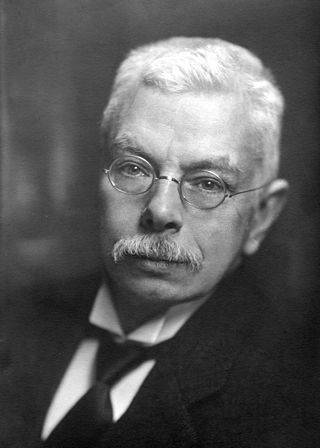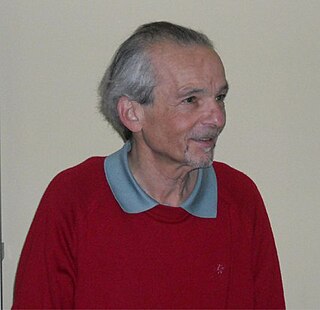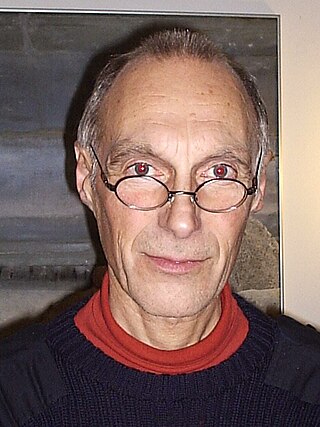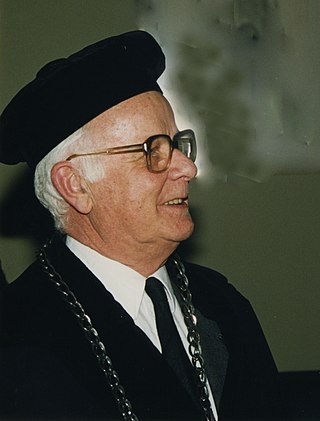
Hendrik Antoon Lorentz was a Dutch physicist who shared the 1902 Nobel Prize in Physics with Pieter Zeeman for the discovery and theoretical explanation of the Zeeman effect. He derived the Lorentz transformation of the special theory of relativity, as well as the Lorentz force, which describes the combined electric and magnetic forces acting on a charged particle in an electromagnetic field. Lorentz was also responsible for the Lorentz oscillator model, a classical model used to describe the anomalous dispersion observed in dielectric materials when the driving frequency of the electric field was near the resonant frequency, resulting in abnormal refractive indices.

Pieter Zeeman was a Dutch physicist who shared the 1902 Nobel Prize in Physics with Hendrik Lorentz for his discovery of the Zeeman effect.
Thermodynamic equilibrium is an axiomatic concept of thermodynamics. It is an internal state of a single thermodynamic system, or a relation between several thermodynamic systems connected by more or less permeable or impermeable walls. In thermodynamic equilibrium, there are no net macroscopic flows of matter nor of energy within a system or between systems. In a system that is in its own state of internal thermodynamic equilibrium, no macroscopic change occurs.
The fluctuation theorem (FT), which originated from statistical mechanics, deals with the relative probability that the entropy of a system which is currently away from thermodynamic equilibrium will increase or decrease over a given amount of time. While the second law of thermodynamics predicts that the entropy of an isolated system should tend to increase until it reaches equilibrium, it became apparent after the discovery of statistical mechanics that the second law is only a statistical one, suggesting that there should always be some nonzero probability that the entropy of an isolated system might spontaneously decrease; the fluctuation theorem precisely quantifies this probability.

Non-equilibrium thermodynamics is a branch of thermodynamics that deals with physical systems that are not in thermodynamic equilibrium but can be described in terms of macroscopic quantities that represent an extrapolation of the variables used to specify the system in thermodynamic equilibrium. Non-equilibrium thermodynamics is concerned with transport processes and with the rates of chemical reactions.

Ludwig Eduard Boltzmann was an Austrian physicist and philosopher. His greatest achievements were the development of statistical mechanics, and the statistical explanation of the second law of thermodynamics. In 1877 he provided the current definition of entropy, , where Ω is the number of microstates whose energy equals the system's energy, interpreted as a measure of statistical disorder of a system. Max Planck named the constant kB the Boltzmann constant.
The Green–Kubo relations give the exact mathematical expression for a transport coefficients in terms of the integral of the equilibrium time correlation function of the time derivative of a corresponding microscopic variable :

Hendrik Brugt Gerhard Casimir was a Dutch physicist who made significant contributions to the field of quantum mechanics and quantum electrodynamics. He is best known for his work on the Casimir effect, which describes the attractive force between two uncharged plates in a vacuum due to quantum fluctuations of the electromagnetic field.

Wander Johannes de Haas was a Dutch physicist and mathematician. He is best known for the Shubnikov–de Haas effect, the De Haas–Van Alphen effect and the Einstein–de Haas effect.

Ryogo Kubo was a Japanese mathematical physicist, best known for his works in statistical physics and non-equilibrium statistical mechanics.

Tatyana Alexeyevna Afanasyeva was a Russian-Dutch mathematician and physicist who made contributions to the fields of statistical mechanics and statistical thermodynamics. On 21 December 1904, she married Austrian physicist Paul Ehrenfest (1880–1933). They had two daughters and two sons; one daughter, Tatyana Ehrenfest, also became a mathematician.

Leonard Salomon Ornstein was a Dutch physicist.
Dmitry Nikolayevich Zubarev was a Soviet and Russian theoretical physicist known for his contributions to statistical mechanics, non-equilibrium thermodynamics, plasma physics, theory of turbulence, and to the development of the double-time Green function's formalism.
Ezechiel Godert David "Eddie" Cohen was a Dutch–American physicist and Professor Emeritus at The Rockefeller University. He is widely recognised for his contributions to statistical physics. In 2004 Cohen was awarded the Boltzmann Medal, jointly with Prof. H. Eugene Stanley. Cohen's citation read "For his fundamental contributions to nonequilibrium statistical mechanics, including the development of a theory of transport phenomena in dense gases, and the characterization of measures and fluctuations in nonequilibrium stationary states."

Bernard Howard Lavenda is a retired professor of chemical physics at the University of Camerino and expert on irreversible thermodynamics. He has contributed to many areas of physics, including that of Brownian motion, and in the establishment of the statistical basis of thermodynamics, and non-Euclidean geometrical theories of relativity. He was the scientific coordinator of the "European Thermodynamics Network" in the European Commission Program of Human Capital and Mobility. He was also a proponent for the establishment of, and scientific director of, a National (Italian) Centre for Thermodynamics, and has acted as scientific consultant to companies such as the ENI Group, where he helped to found TEMA, a consulting firm for SNAM Progetti, ENEA, and the Solar Energy Research Institute in Golden, Colorado. He has had over 130 scientific papers published in international journals, some critical of the new fashions and modes in theoretical physics.
Nicolaas 'Nico' Godfried van Kampen was a Dutch theoretical physicist, who worked mainly on statistical mechanics and non-equilibrium thermodynamics.
Vladimir Nikolajevich Pokrovskii is a Russian scientist known for his original contributions to polymer physics and economic theory. He was the founder of the Altai school of dynamics of nonlinear fluids.

Hans J. van Ommeren Dekker is a Dutch theoretical physicist in the line of Dirk Polder, Ralph Kronig, and Nico van Kampen. His scientific work inter alia involves laser theory, path integrals in curved spaces, nonequilibrium statistical mechanics, dissipation in quantum mechanics, and hydrodynamic turbulence. He is director of the Private Institute for Advanced Study and professor emeritus at the Institute for Theoretical Physics of the University of Amsterdam.

Wim van Saarloos is a Dutch physicist, academic and researcher. He is a Professor of Theoretical Physics at Leiden University

Joannes Joseph Maria Beenakker, more often known as Jan J. M. Beenakker or Jan Beenakker, was a Dutch physicist and the rector of the Leiden University.












